Application of Gob-Side Entry Driving in Fully Mechanized Caving Mining: A Review of Theory and Technology
Abstract
:1. Introduction
2. Research on the Theoretical Model of Gob-Side Entry Driving in Fully Mechanized Caving Mining
2.1. Activity Law of Overlying Strata in Gob-Side Entry Driving
2.1.1. Mechanical Model of the “Triangle-Block”
- (1)
- The lateral breaking “large structure” model
- (2)
- Compound key triangle block structure model in the middle and low position
- (3)
- The high and low right angle key block stability mechanics model
2.1.2. Mechanical Model of the “Beam”
- (1)
- Elastic foundation beam model
- (2)
- Low-level combined cantilever beam + high-level multilayer masonry beam structure model
- (3)
- The vertical triangular slip zone structure model
2.2. Surrounding Rock Control of Fully Mechanized Caving Section Roadway
2.2.1. The “Internal and External Stress Field Theory”
2.2.2. The “Stress Limit Equilibrium Zone Model”
3. Numerical Analysis Method of Gob-Side Entry Driving in Fully Mechanized Caving Mining
3.1. Constitutive Model of FLAC3D
3.1.1. Strain-Softening Model of Yielding Coal Pillar
3.1.2. Double-Yield Model of Goaf
3.2. UDEC Simulation of Coal Pillar Fracture
3.3. Other Numerical Analysis Methods
4. Surrounding Rock Control Technology of Gob-Side Entry Driving in Fully Mechanized Caving Mining
4.1. Two-Rib Support of the Roadway
4.1.1. Support of Coal Pillar Rib
4.1.2. Support of Virgin Coal Rib
4.2. Roof Support of Gob-Side Entry Driving
4.2.1. Single Anchor Cable Support or Anchor Cable + Steel Strip Support
4.2.2. Anchor Cable Truss Support
4.2.3. Cable Beam Truss Support
4.2.4. Anchor Cable + Channel Steel Support
4.2.5. Step Bundled Anchor Cable Support

4.3. Support under Difficult Conditions such as a Broken Roof
5. Engineering Monitoring
6. Discussion
- (1)
- With the wide application of gob-side entry driving without a coal pillar or with a narrow coal pillar, theoretical research on the activity law of the overlying strata and the stability control of the surrounding rock is gradually improved and developed. It lays a solid theoretical foundation for further promotion and application.
- (2)
- Numerical simulation is an important technical means to study the problem of gob-side entry driving in fully mechanized caving. By selecting the appropriate constitutive model and numerical simulation software, the crack propagation morphology and plastic state in the coal pillar can be simulated, which can guide the reasonable location of gob-side entry driving and the design width of the coal pillar.
- (3)
- The stability of the surrounding rock in the gob-side entry of fully mechanized caving is essential. On the side of the virgin coal rib, bolt cable support is often used with a ladder beam of steel (W, JW steel strip) and mesh. On the side of the coal pillar rib, it is mainly divided into three categories: anchor cable support, concrete wall support on the side of the roadway, and filling support on the side of the goaf; among them, the process of pouring a concrete wall and filling support is cumbersome and costly, which is only used under some special conditions. In the roof of the roadway, five kinds of support forms, such as anchor cable support, anchor cable truss support, anchor beam truss support, anchor cable + channel steel support, and step bundle anchor cable support, are often used. The roof often adopts a combination of multiple support methods. Under complete conditions, such as a broken roof, the deformation of the roadway is controlled by shed support, anchor cable grouting composite support, and other forms.
- (4)
- Mine pressure monitoring is a research method often used in engineering. Understanding the stress and deformation law of surrounding rock in gob-side entry driving is essential in optimizing the support design scheme using microseismic monitoring, dynamic stress monitoring, and borehole peeping for on-site engineering monitoring.
- (5)
- Gob-side entry driving in fully mechanized caving is an important method of thick coal seam mining. In the future, we still need to strengthen the research on the basic theory to help us gain a more in-depth understanding of the various problems in gob-side entry driving. Further, we need to explore the nonpillar mining technology and develop more effective surrounding rock control technology to improve the recovery rate of coal resources in fully mechanized caving mining. In addition, the future method of gob-side entry driving with fully mechanized caving will also take into account precision, automation, and greening to realize safe and efficient mining of coal mines.
Author Contributions
Funding
Conflicts of Interest
References
- Zhang, P.; Zhai, E.; Cheng, A.; Xu, S.; Sun, B. Optical Fiber Monitoring Study on Characteristics of Deformation in Floor of Deep and Thick Coal Seam During Mining. Chin. J. Undergr. Space Eng. 2019, 15, 1197–1203+1211. [Google Scholar]
- Xie, S.; Wu, Y.; Ma, X.; Chen, D.; Guo, F.; Jiang, Z.; Li, H.; Zou, H.; Liu, R.; Zhang, X. Reasonable Stopping Method and Retracement Channel Support at Fully Mechanized Top Coal Caving Working Face of 15 m Extra-Thick Coal Seam: A Case Study. Energy Sci. Eng. 2022, 10, 4336–4357. [Google Scholar] [CrossRef]
- Klishin, V.I. Innovative Technologies for Thick Coal Seam Mining on the Basis of Powered Roof Support with Controlled Coal Discharge. IOP Conf. Ser. Earth Environ. Sci. 2019, 262, 12027. [Google Scholar] [CrossRef]
- Kurlenya, M.V.; Klishin, V.I.; Kubanychbek. Pressure Control and Top Coal Drawing by Powered Machine Complexes in Mining at Thick Coal Seams. Gospod. Surowcami Miner. 2008, 24, 25–35. [Google Scholar]
- Ju, W. Study on Reasons of Rock Burst in Roadway and Prevention Technology of Steeply-Inclined and Extremely Thick Coal Seam with Horizontally Slicing Way. Ph.D. Thesis, Beijing Jiaotong University, Beijing, China, 2009. [Google Scholar]
- Song, G.; Stankus, J. Control Mechanism of a Tensioned Bolt System in the Laminated Roof with a Large Horizontal Stress. In Proceedings of the 16th International Conference on Ground Control in Mining, Morgantown, WV, USA, 5–7 August 1997. [Google Scholar]
- Sellers, E.J.; Klerck, P. Modeling of the Effect of Discontinuities on the Extent of the Fracture Zone Surrounding Deep Tunnels. Tunn. Undergr. Space Technol. 2000, 15, 463–469. [Google Scholar] [CrossRef]
- Fairhurst, C. Deformation, Yield, Rupture and Stability of Excavations at Great Depth. Int. Soc. Rock Mech. Rock Eng. 1989, 98, 1103–1114. [Google Scholar]
- Mei, X. Surrounding Rock Stability and Asymmetric Support of Large Section Gob-Side Entry Driving in Fully Mechanized Caving. Ph.D. Thesis, China University of Mining and Technology, Beijing, China, 2016. [Google Scholar]
- Yang, K.; Xie, G. Study on Asymmetrical Bolting Support of Retreating Entry in Large Dip Coal Seam and It’s Practice. Chin. J. Undergr. Space Eng. 2013, 9, 924–927. [Google Scholar]
- Kang, H.; Zhang, X.; Wang, D.; Tian, J.; Yi, Z.; Jiang, W. Strata Control Technology and Applications of Non-Pillar Coal Mining. J. China Coal Soc. 2022, 47, 16–44. [Google Scholar]
- Chen, D.; Guo, F.; Li, Z.; Ma, X.; Xie, S.; Wu, Y.; Wang, Z. Study on the Influence and Control of Stress Direction Partial-Stress Boosting of Main Deflection and Roadways Surrounding Rock and under the Influence of Multi-Seam Mining. Energies 2022, 15, 8257. [Google Scholar] [CrossRef]
- Xie, S.; Wu, Y.; Guo, F.; Zou, H.; Chen, D.; Zhang, X.; Ma, X.; Liu, R.; Wu, C. Application of Pre-Splitting and Roof-Cutting Control Technology in Coal Mining: A Review of Technology. Energies 2022, 15, 6489. [Google Scholar] [CrossRef]
- Dychkovskyi, R.; Shavarskyi, I.; Saik, P.; Lozynskyi, V.; Falshtynskyi, V.; Cabana, E. Research into Stress-Strain State of the Rock Mass Condition in the Process of the Operation of Double-Unit Longwalls. Min. Miner. Depos. 2020, 14, 85–94. [Google Scholar] [CrossRef]
- Vu, T.T. Solutions to Prevent Face Spall and Roof Falling in Fully Mechanized Longwall at Underground Mines, Vietnam. Min. Miner. Depos. 2022, 16, 127–134. [Google Scholar] [CrossRef]
- Matayev, A.; Kainazarova, A.; Arystan, I.; Abeuov, Y.; Kainazarov, A.; Baizbayev, M.; Demin, V.; Sultanov, M. Research into Rock Mass Geomechanical Situation in the Zone of Stope Operations Influence at the 10th Anniversary of Kazakhstan’s Independence Mine. Min. Miner. Depos. 2021, 15, 103–111. [Google Scholar] [CrossRef]
- Kumar, R.; Mishra, A.K.; Kumar, A.; Singh, A.K.; Ram, S.; Singh, R. Importance of Fracturing Hard and Massive Overlying Strata for Complete Extraction of Thick Coal Seam—Case Studies. J. Geol. Soc. India 2022, 98, 203–210. [Google Scholar] [CrossRef]
- Xie, S.; Chen, D.; Zeng, J.; Gao, M.; Zhang, T.; Liu, J. First Fracturing Characteristics of Main Roof Plate Structure Considering Coal Pillars and Elastic Coal Foundation on Both Sides of Stope. J. China Coal Soc. 2019, 44, 115–126. [Google Scholar]
- He, F.; He, W.; Chen, D.; Xie, S.; Li, H.; He, C. First Fracture Structure Characteristics of Main Roof Plate Considering Elastic-Plastic Deformation of Coal. J. China Coal Soc. 2020, 45, 2704–2717. [Google Scholar]
- Chen, D.; Wu, Y.; Xie, S.; He, F.; Sun, Y.; Shi, S.; Jing, Z. Study on the First Fracture of the Main Roof Plate Structure with One Side Goaf and Elastic-Plastic Foundation Boundary. J. China Coal Soc. 2021, 46, 3090–3105. [Google Scholar]
- Chen, D.; Guo, F.; Wu, Y.; Xie, S.; He, F.; Liu, R.; Wu, C. Study on the First Fracture of The Main Roof Plate Structure with the Long Side Goaf and Elastic-Plastic Softening Foundation Boundary. J. China Coal Soc. 2022, 47, 1473–1489. [Google Scholar]
- Castelli, F.; Grasso, S.; Lentini, V.; Sammito, M.S.V. Effects of Soil-Foundation-Interaction on the Seismic Response of a Cooling Tower by 3D-FEM Analysis. Geosciences 2021, 11, 200. [Google Scholar] [CrossRef]
- Zhang, G.; He, F.; Jia, H.; Lai, Y. Analysis of Gateroad Stability in Relation to Yield Pillar Size: A Case Study. Rock Mech. Rock Eng. 2017, 50, 1263–1278. [Google Scholar] [CrossRef]
- Li, W.; Bai, J.; Peng, S.; Wang, X.; Xu, Y. Numerical Modeling for Yield Pillar Design: A Case Study. Rock Mech. Rock Eng. 2015, 48, 305–318. [Google Scholar] [CrossRef]
- Jiang, L.; Zhang, P.; Chen, L.; Hao, Z.; Sainoki, A.; Mitri, H.S.; Wang, Q. Numerical Approach for Goaf-Side Entry Layout and Yield Pillar Design in Fractured Ground Conditions. Rock Mech. Rock Eng. 2017, 50, 3049–3071. [Google Scholar] [CrossRef]
- Wang, E.; Xie, S. Determination of Coal Pillar Width for Gob-Side Entry Driving in Isolated Coal Face and Its Control in Deep Soft-broken Coal Seam: A Case Study. Energy Sci. Eng. 2022, 10, 2305–2316. [Google Scholar] [CrossRef]
- Shen, W.; Xiao, T.; Wang, M.; Bai, J.; Wang, X. Numerical Modeling of Entry Position Design: A Field Case. Int. J. Min. Sci. Technol. 2018, 28, 985–990. [Google Scholar] [CrossRef]
- Xie, S.; Wang, E.; Chen, D.; Li, H.; Jiang, Z.; Yang, H. Stability Analysis and Control Technology of Gob-Side Entry Retaining with Double Roadways by Filling with High-Water Material in Gently Inclined Coal Seam. Int. J. Min. Sci. Technol. 2022, 9, 52. [Google Scholar] [CrossRef]
- Chen, D.; Wu, Y.; Xie, S.; Guo, F.; He, F.; Liu, R. Reasonable Location of Stopping Line in Close-Distance Underlying Coal Seam and Partition Support of Large Cross-Section Roadway. Int. J. Min. Sci. Technol. 2022, 9, 52. [Google Scholar] [CrossRef]
- Xie, S.; Wu, Y.; Chen, D.; Liu, R.; Han, X.; Ye, Q. Failure Analysis and Control Technology of Intersections of Large-Scale Variable Cross-Section Roadways in Deep Soft Rock. Int. J. Min. Sci. Technol. 2022, 9, 19. [Google Scholar] [CrossRef]
- Yue, S.; Xie, S.; Chen, D.; Gao, M.; Zhang, Q.; Zhang, T. Research on Surrounding Rocks Control of Narrow Pillar with High-Intensity Fully-Mechanized Top Coal Caving Mining in 15 m Ultra-Thick Coal Seam. J. Min. Saf. Eng. 2017, 34, 905–913. [Google Scholar]
- Guo, J.; Wang, W.; Yue, S.; He, F.; Gao, M.; Xie, S. Surrounding Rock Control Mechanism and Its Application of Gob-Side Driving Entry in Extra Thick Coal Seam. J. China Coal Soc. 2017, 42, 825–832. [Google Scholar]
- Xie, S.; Wu, X.; Chen, D.; Sun, Y.; Wang, E.; Wu, X.; Duan, X.; Jiang, Z.; Qi, P.; Shi, S. Failure Mechanism and Control Technology of Thick and Soft Coal Fully Mechanized Caving Roadway under Double Gobs in Close Coal Seams. Shock Vib. 2020, 2020, 8846014. [Google Scholar] [CrossRef]
- Zhang, G.; He, F. Asymmetric Failure and Control Measures of Large Cross-Section Entry Roof with Strong Mining Disturbance and Fully-Mechanized Caving Mining. Chin. J. Rock Mech. Eng. 2016, 35, 806–818. [Google Scholar]
- Guo, J.; Wang, W.; He, F.; Zhang, G. Main Roof Break Structure and Surrounding Stability Analysis in Gob-Side Entry with Fully-Mechanized Caving Mining. J. Min. Saf. Eng. 2019, 36, 446–454+464. [Google Scholar]
- Wei, Z.; He, F.; Zhang, G.; Gao, Y.; Lai, Y. Failure Mechanism and Cable Truss Control of Large-Scale Section Gob-Side Entry Roof with Fully-Mechanized Caving. J. Min. Saf. Eng. 2017, 34, 1. [Google Scholar]
- Zhang, G.; He, F. Pillar Width Determination and Surrounding Rocks Control of Gob-Side Entry with Large Cross-Section and Fully-Mechanized Mining. Rock Soil Mech. 2016, 37, 1721–1728+1736. [Google Scholar]
- Jiang, W. Deformation Mechanism and Stability Control of Roadway Along Goaf in Fully Mechanized Top Coal Caving Face with Thick and Hard Roof. Ph.D. Thesis, China University of Mining and Technology, Beijing, China, 2021. [Google Scholar]
- Xie, S.; Jiang, Z.; Chen, D.; Wang, E.; Lv, F. A New Pressure Relief Technology by Internal Hole-Making to Protect Roadway in Two Sides of Deep Coal Roadway: A Case Study. Rock Mech. Rock Eng. 2023, 56, 1537–1561. [Google Scholar] [CrossRef]
- Xie, S.; Li, H.; Chen, D.; Feng, S.; Ma, X.; Jiang, Z.; Cui, J. New Technology of Pressure Relief Control in Soft Coal Roadways with Deep, Violent Mining and Large Deformation: A Key Study. Energies 2022, 15, 9208. [Google Scholar] [CrossRef]
- Xie, S.; Wang, E.; Chen, D.; Jiang, Z.; Li, H.; Liu, R. Collaborative Control Technology of External Anchor-Internal Unloading of Surrounding Rock in Deep Large-Section coal Roadway Under Strong Mining Influence. J. China Coal Soc. 2022, 47, 1946–1957. [Google Scholar]
- Bo, J.; Wang, W.; Hou, Z.; Huang, H. Control Mechanism and Support Technique about Gateway Driven along Goaf in Fully Mechanized Top Coal Caving Face. J. China Coal Soc. 2000, 5, 478–481. [Google Scholar]
- Xie, S.; Wu, Y.; Guo, F.; Chen, D.; Wang, E.; Zhang, X.; Zou, H.; Liu, R.; Ma, X.; Li, S. Interaction Mechanism of the Upper and Lower Main Roofs with Different Properties in Close Coal Seams: A Case Study. Energies 2022, 15, 5533. [Google Scholar] [CrossRef]
- Wang, D.; Li, S.; Wang, Q.; Li, W.; Wang, F.; Wang, H.; Peng, P.; Ruan, G. Experimental Study of Reasonable Coal Pillar Width in Fully Mechanized Top Coal Caving Face of Deep Thick Coal Seam. Chin. J. Rock Mech. Eng. 2014, 33, 539–548. [Google Scholar]
- Bo, J.; Hou, C.; Huang, H. Numerical Simulation Study on Stability of Narrow Coal Pillar of Roadway Driving Along Goaf. Chin. J. Rock Mech. Eng. 2004, 20, 3475–3479. [Google Scholar]
- Hou, C.; Li, X. Stability Principle of Big and Small Structures of Rock Surrounding Roadway Driven Along Goaf in Fully Mechanized Top Coal Caving face. J. China Coal Soc. 2001, 1, 1–7. [Google Scholar]
- Gao, S. Mechanism and Control of Surrounding Rock Failure of the Adjacent Goaf Broken Coal Roadway in Lower Position of Double Lane in Different Layers at Fully-Mechanized Coal Caving Sector. Ph.D. Thesis, China University of Mining and Technology, Beijing, China, 2021. [Google Scholar]
- He, W. Study on Strata Structure Characteristic and Surrounding Rock Control of Gob-Side Entry with Narrow Coal Pillar for Longwall Caving Mining in Extra-Thick Coal Seam. Ph.D. Thesis, China University of Mining and Technology, Beijing, China, 2021. [Google Scholar]
- Xie, F. Fracture Location and Structural Stability of Overlying Strata in Top-Coal Caving Gob-Side Entry. Ph.D. Thesis, China University of Mining and Technology, Beijing, China, 2017. [Google Scholar]
- Du, B. Study on Strong Ground Pressure Mechanism of Gob-Side Roadway and its Control in Extra Thick Coal Seam with Hard Roof. Ph.D. Thesis, China University of Mining and Technology, Beijing, China, 2022. [Google Scholar]
- Li, H.; Wang, Z. Research and Application of Small Coal Pillar Gob-Side Entry Driving in Extremely Thick Coal Seam with Large Mining Height and Fully Mechanized Caving Face. Datong Coal Sci. Technol. 2019, 03, 1–8+53. [Google Scholar]
- Li, L.; Bo, J.; Wang, X. Rational Position and Control Technique of Roadway Driving Along Next Goaf in Fully Mechanized Top Coal Caving Face. J. China Coal Soc. 2012, 37, 1564–1569. [Google Scholar]
- Cha, W.; Li, X.; Hua, X.; Wu, T.; Yin, S. Impact and Application on Narrow Coal Pillar for Roadway Protecting from Fracture Position of Upper Roof. J. China Coal Soc. 2014, 39, 332–338. [Google Scholar]
- Wang, D.; Wang, H.; Li, S.; Wang, Q.; Song, Y. Stress and Deformation Analysis of the Side Wall in a Roadway Driven Along Goaf Incorporating the Strength Softening Characteristics of Coal Mass. J. China Univ. Min. Technol. 2019, 48, 295–304. [Google Scholar]
- Qi, F.; Zhou, Y.; Cao, Z.; Zhang, Q.; Li, N. Width Optimization of Narrow Coal Pillar of Roadway Driving Along Goaf in Fully Mechanized Top Coal Caving Face. J. Min. Saf. Eng. 2016, 33, 475–480. [Google Scholar]
- Wang, W.; Huang, C.; Hou, C.; Peng, G. Mechanical Deformation Analysis of Floor Strata of Roadway Driving Along Next Goaf in Fully Mechanized Sub-Level Caving Face. J. China Coal Soc. 2002, 1, 26–30. [Google Scholar]
- Zhu, W.; Guan, K.; Liu, H.; Niu, L.; Liu, X.; Hou, C.; Deng, W. Applied Rock Mechanics; Metallurgical Industry Press: Beijing, China, 2022. [Google Scholar]
- Shi, C.; Zhang, Q.; Wang, S. Numerical Simulation Technology and Application with Particle Flow Code (PFC5.0); China Building Industry Press: Beijing, China, 2018. [Google Scholar]
- Itasca Consulting Group Inc. UDEC (Universal Distinct Element Code)User’s Manual Version 6.0; ITASCA Consulting Group Inc.: Minneapolis, MN, USA, 2014. [Google Scholar]
- Itasca Consulting Group Inc. FLAC 3D (Version 5.0) User’s Manual; ITASCA Consulting Group Inc.: Minneapolis, MN, USA, 1986. [Google Scholar]
- Wang, T.; Han, X.; Zhao, X. FLAC3D Numerical Simulation Method and Engineering Application—In-Depth Analysis of FLAC3D5.0; China Building Industry Press: Beijing, China, 2015. [Google Scholar]
- Chen, D.; Wang, E.; Xie, S.; He, F.; Wang, L.; Zhang, Q.; Wu, X.; Jiang, Z.; Li, Y.; Shi, S. Roadway Surrounding Rock under Multi-Coal-Seam Mining: Deviatoric Stress Evolution and Control Technology. Adv. Civ. Eng. 2020, 2020, 9891825. [Google Scholar] [CrossRef]
- Chen, D.; Guo, F.; Xie, S.; Wang, E.; Wu, Y.; Jiang, Z.; Wang, L.; Cui, J.; Zhang, X.; Liu, R. Mining-induced Failure Characteristics and Surrounding Rock Control of Gob-side Entry Driving Adjacent to Filling Working Face in the Deep Coal Mine. Energy Sci. Eng. 2022, 10, 2593–2611. [Google Scholar] [CrossRef]
- Lu, Y.; Wang, L.; Yang, F.; Li, Y.; Chen, H. Post-Peak Strain Softening Mechanical Properties of Weak Rock. Chin. J. Rock Mech. Eng. 2010, 29, 640–648. [Google Scholar]
- Zhang, F.; Sheng, Q.; Zhu, Z.; Zhang, Y. Study on Post-Peak Mechanical Behaviour and Strain-Softening Model of Three Gorges Granite. Chin. J. Rock Mech. Eng. 2008, 27, 2651–2655. [Google Scholar]
- Medhurst, T.P.; Brown, E.T. A Study of the Mechanical Behaviour of Coal for Pillar Design. Int. J. Rock Mech. Min. Sci. 1998, 35, 1087–1105. [Google Scholar] [CrossRef]
- Yavuz, H. An Estimation Method for Cover Pressure Re-Establishment Distance and Pressure Distribution in the Goaf of Longwall Coal Mines. Int. J. Rock Mech. Min. Sci. 2004, 41, 193–205. [Google Scholar] [CrossRef]
- Guo, Z.; Zhang, L.; Ma, Z.; Zhong, F.; Yu, J.; Wang, S. Numerical Investigation of the Influence of Roof Fracturing Angle on the Stability of Gob-Side Entry Subjected to Dynamic Loading. Shock Vib. 2019, 2019, 1434135. [Google Scholar] [CrossRef]
- Zhang, G.; Liang, S.; Tan, Y.; Xie, F.; Chen, S.; Jia, H. Numerical Modeling for Longwall Pillar Design: A Case Study from a Typical Longwall Panel in China. J. Geophys. Eng. 2018, 15, 121–134. [Google Scholar] [CrossRef]
- Wang, J.; Qiu, P.; Ning, J.; Zhuang, L.; Yang, S. A Numerical Study of the Mining-induced Energy Redistribution in a Coal Seam Adjacent to an Extracted Coal Panel during Longwall Face Mining: A Case Study. Energy Sci. Eng. 2020, 8, 817–835. [Google Scholar] [CrossRef] [Green Version]
- Yang, R.; Zhu, Y.; Li, Y.; Li, W.; Lin, H. Coal Pillar Size Design and Surrounding Rock Control Techniques in Deep Longwall Entry. Arab. J. Geosci. 2020, 13, 453. [Google Scholar] [CrossRef]
- Li, M.; Zhang, J.; Huang, Y.; Zhou, N. Effects of Particle Size of Crushed Gangue Backfill Materials on Surface Subsidence and Its Application under Buildings. Environ. Earth Sci. 2017, 76, 603. [Google Scholar] [CrossRef]
- Yadav, A.; Behera, B.; Sahoo, S.K.; Singh, G.S.P.; Sharma, S.K. An Approach for Numerical Modeling of Gob Compaction Process in Longwall Mining. Min. Metall. Explor. 2020, 37, 631–649. [Google Scholar] [CrossRef]
- Chen, Y.; Xu, D. FLAC/FLAC3D Foundation and Engineering Examples; China Water & Power Press: Beijing, China, 2013. [Google Scholar]
- Peng, W. FLAC3D Practical Tutorial, Version 2; China Machine Press: Beijing, China, 2020. [Google Scholar]
- Salamon, M.D.G. Stability, Instability and Design of Pillar Workings. Int. J. Rock Mech. Min. Sci. Geomech. Abstr. 1970, 7, 613–631. [Google Scholar] [CrossRef]
- Salamon, M.D.G. Mechanism of Caving in Longwall Coal Mining. In Proceedings of the 31st US Symposium on Rock Mechanics, Colorado School of Mines, Golden, CO, USA, 18–20 June 1990. [Google Scholar]
- Gao, F.; Stead, D.; Kang, H. Simulation of Roof Shear Failure in Coal Mine Roadways Using an Innovative UDEC Trigon Approach. Comput. Geotech. 2014, 61, 33–41. [Google Scholar] [CrossRef]
- Gao, F.; Stead, D.; Kang, H. Numerical Simulation of Squeezing Failure in a Coal Mine Roadway Due to Mining-Induced Stresses. Rock Mech. Rock Eng. 2015, 48, 1635–1645. [Google Scholar] [CrossRef]
- Wu, W.; Bai, J.; Wang, X.; Yan, S.; Wu, S. Numerical Study of Failure Mechanisms and Control Techniques for a Gob-Side Yield Pillar in the Sijiazhuang Coal Mine, China. Rock Mech. Rock Eng. 2019, 52, 1231–1245. [Google Scholar] [CrossRef]
- Gao, F.; Stead, D.; Kang, H.; Wu, Y. Discrete Element Modelling of Deformation and Damage of a Roadway Driven along an Unstable Goaf—A Case Study. Int. J. Coal Geol. 2014, 127, 100–110. [Google Scholar] [CrossRef]
- Vergara, M.R.; Van Sint Jan, M.; Lorig, L. Numerical Model for the Study of the Strength and Failure Modes of Rock Containing Non-Persistent Joints. Rock Mech. Rock Eng. 2016, 49, 1211–1226. [Google Scholar] [CrossRef]
- Wu, B.; Wang, X.; Bai, J.; Wu, W.; Zhu, X.; Li, G. Study on Crack Evolution Mechanism of Roadside Backfill Body in Gob-Side Entry Retaining Based on UDEC Trigon Model. Rock Mech. Rock Eng. 2019, 52, 3385–3399. [Google Scholar] [CrossRef]
- Gao, F.Q.; Kang, H.P. Effects of Pre-Existing Discontinuities on the Residual Strength of Rock Mass—Insight from a Discrete Element Method Simulation. J. Struct. Geol. 2016, 85, 40–50. [Google Scholar] [CrossRef]
- Chen, X.; Xiao, T.; She, H. Triaxial Compression Condition Order Fracture Rock Fissure Extension Study. Sci. Technol. Eng. 2022, 22, 11567–11576. [Google Scholar]
- Rong, H.; Li, G.; Liang, D.; Xu, J.; Hu, Y. Particle Flow Simulation of Mechanical Properties of High Stress Rock under the Influence of Stress Path. J. Min. Saf. Eng. 2022, 39, 163–173. [Google Scholar]
- Wu, D.; Wei, L.; Su, H.; Wu, J.; Liu, R.; Zhou, J. Experimental Study and PFC3D Simulation on Crack Propagation of Fractured Rock-like Specimens with Bolts under Uniaxial Compression. Rock Soil Mech. 2021, 42, 1681–1692. [Google Scholar]
- Hou, F.; Zhang, L.; Jiang, Q.; Feng, C.; Li, S. Hydraulic Fracturing Characteristics of Water Resisting Rock Mass with Layered Joints Based on CDEM. Hazard Control Tunn. Undergr. Eng. 2021, 3, 76–84. [Google Scholar]
- Zhao, Y.; Sun, Z.; Song, H.; Zhao, S. Crack Propagation Law of Mode Ⅰ Dynamic Fracture of Coal: Experiment and Numerical Simulation. J. China Coal Soc. 2020, 45, 3961–3972. [Google Scholar]
- Zhang, W.; Zhang, D.; Chen, J.; Xu, M. Control of Surrounding Rock Deformation for Gob-Side Entry Driving in Narrow Coal Pillar of Island Coalface. J. China Univ. Min. Technol. 2014, 43, 36–42+55. [Google Scholar]
- Zhao, Q.; Du, F.; Li, Q.; Qian, W.; Shan, Y. Surrounding Rock Control Technology of Gateway Driven Along Goaf in Fully-Mechanized Coal Mining Face. Coal Sci. Technol. 2015, 43, 23–28. [Google Scholar] [CrossRef]
- Dong, H. Ground Control of Narrow Coal Pillar in Gob Side Entry Driving with Fully Mechanized Top Coal Caving Mining in Extra-Thick Coal Seam. J. Min. Strat. Control Eng. 2021, 3, 32–42. [Google Scholar]
- Li, X.; Ju, M.; Jia, S.; Chong, Z. Study of Influential Factors on the Stability of Narrow Coal Pillar in Gob-Side Entry Driving and Its Engineering Application. J. Min. Saf. Eng. 2016, 33, 761–769. [Google Scholar]
- Zhang, H.; Wan, Z.; Zhang, Y.; Ma, Z.; Zhang, J.; Liu, S.; Ge, L. Deformation Mechanism of Narrow Coal Pillar in the Fully-Mechanized Gob-Side Entry with Incompletely Stable Overlying Strata. J. Min. Saf. Eng. 2016, 33, 692–698. [Google Scholar]
- Zhang, H.; Wan, Z.; Zhang, Y. Mechanism of Grouted-Reinforcement in Last Roadway for Pillar in the Fully-Mechanized Gob-Side Entry. J. Min. Saf. Eng. 2018, 35, 489–495. [Google Scholar]
- He, F.; Li, K. Arc-Connection Locker for Girder Anchor Cable. CN Patent 201236719[P], 13 March 2009. [Google Scholar]
- Yan, H.; He, F.; Wang, S. Safety Control and Evaluation of Roadway with Super-Large Cross-Section and Soft-Weak Thick Coal Roof. Chin. J. Rock Mech. Eng. 2014, 33, 1014–1023. [Google Scholar]
- Kang, R.; He, F.; Li, H. Application of Truss and Anchor to Support Seam Gateway with Broken Roof. Coal Sci. Technol. 2010, 38, 28–33. [Google Scholar]
- Kang, H.; Wang, J.; Lin, J. Study and Applications of Roadway Support Techniques for Coalmines. J. China Coal Soc. 2012, 35, 1809–1814. [Google Scholar]
- Su, X.; Song, X.; Li, H.; Yuan, H.; Li, M. Study on Coupled Arch-Beam Support Structure of Roadway with Extra-Thick Soft Compound Roof. Chin. J. Rock Mech. Eng. 2014, 33, 1828–1836. [Google Scholar]
- He, W.; He, F.; Chen, D.; Chen, Q. Pillar Width and Surrounding Rock Control of Gob-Side Roadway with Mechanical Caved Mining in Extra-Thick Coal Seams under Hard-Thick Main Roof. J. Min. Saf. Eng. 2020, 37, 349–358, 365. [Google Scholar]
- Cheng, Y.; Jiang, F.; Pang, J. Research on Lateral Strata Pressure Characteristic in Goaf of Top Coal Caving in Extra Thick Coal Seam and Its Application. J. China Coal Soc. 2012, 37, 1088–1093. [Google Scholar]
- Yin, S.; Cheng, G.; He, F.; Xie, F.; Shan, Y. An Asymmetric Support Technique for Fully-Mechanized Coal Roadway Nearby Narrow Pillar Based on the Fracture Position Analysis in Basic Roof. Chin. J. Rock Mech. Eng. 2016, 35, 3162–3174. [Google Scholar]
- Zhang, G. Asymmetric Failure Mechanism and Regulation System of Gob-Side Entry Roof with Fully-Mechanized Caving Mining and a Loose and Weak Coal Pillar. Ph.D. Thesis, China University of Mining and Technology, Beijing, China, 2017. [Google Scholar]
- Hao, D.; Cui, Q.; He, J.; Guo, X.; Cheng, P. Deformation Characteristics and Separation Monitoring of Layered Roof Roadway Supported with Bolts and Cables. J. China Coal Soc. 2017, 42, 43–50. [Google Scholar]

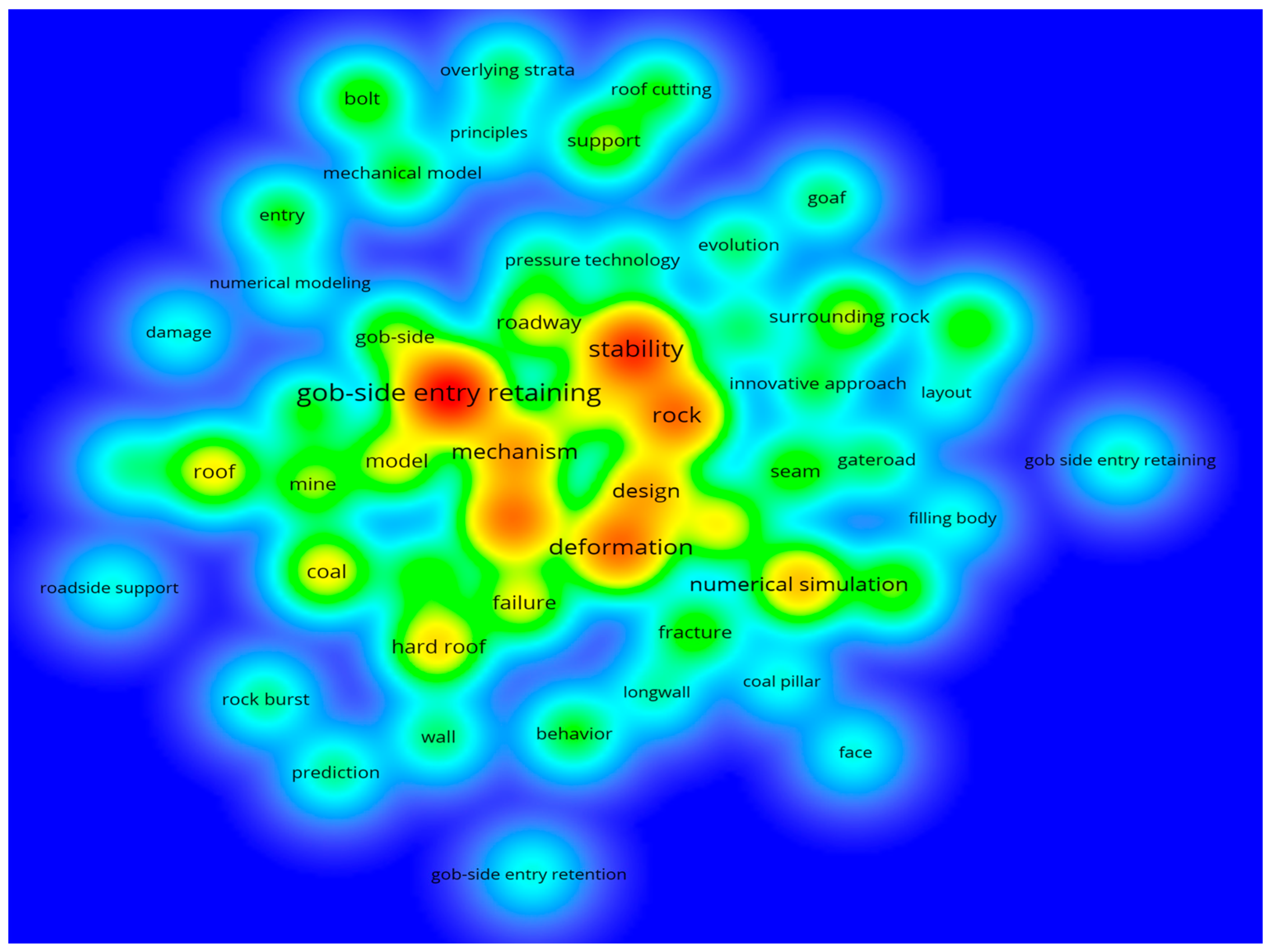
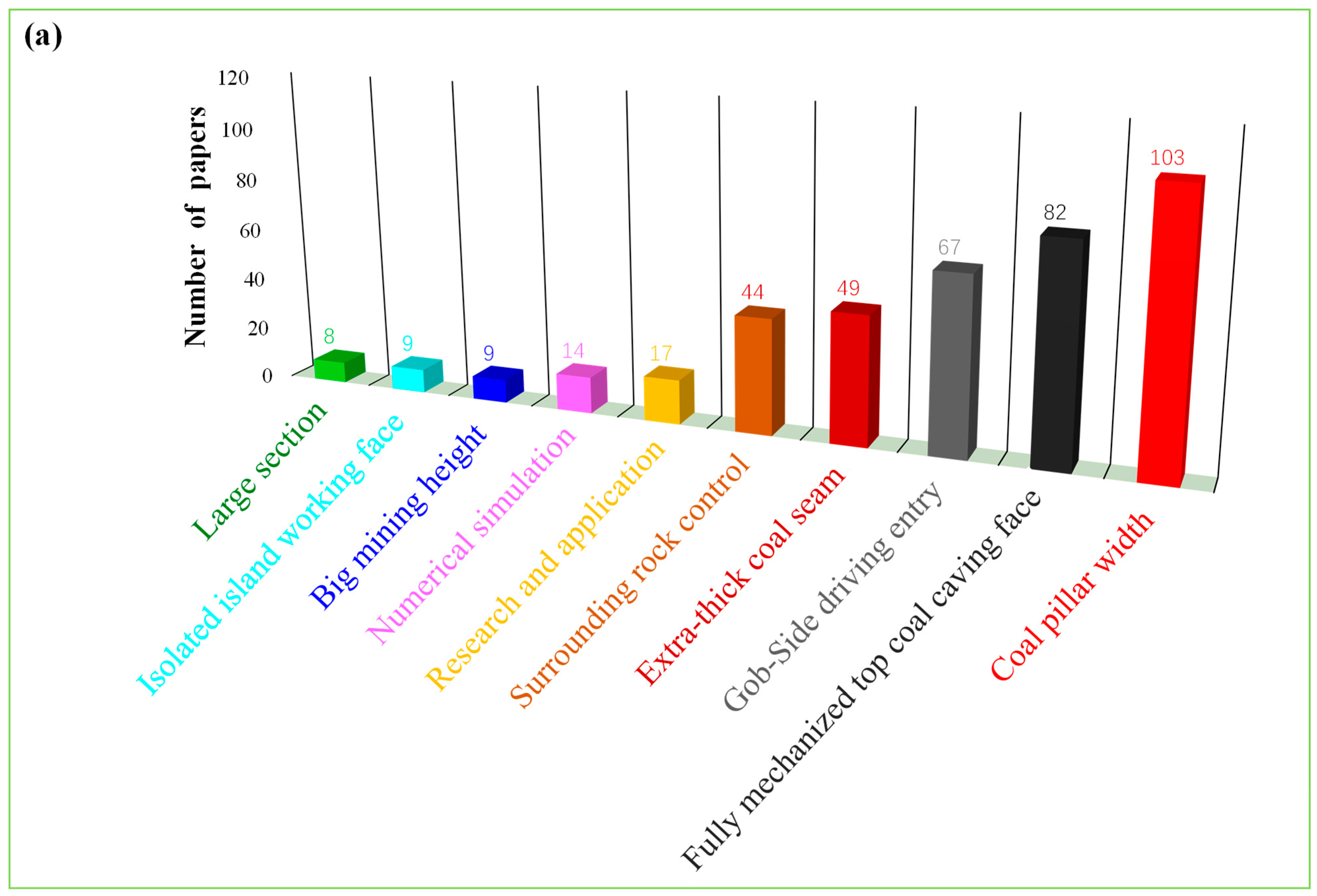
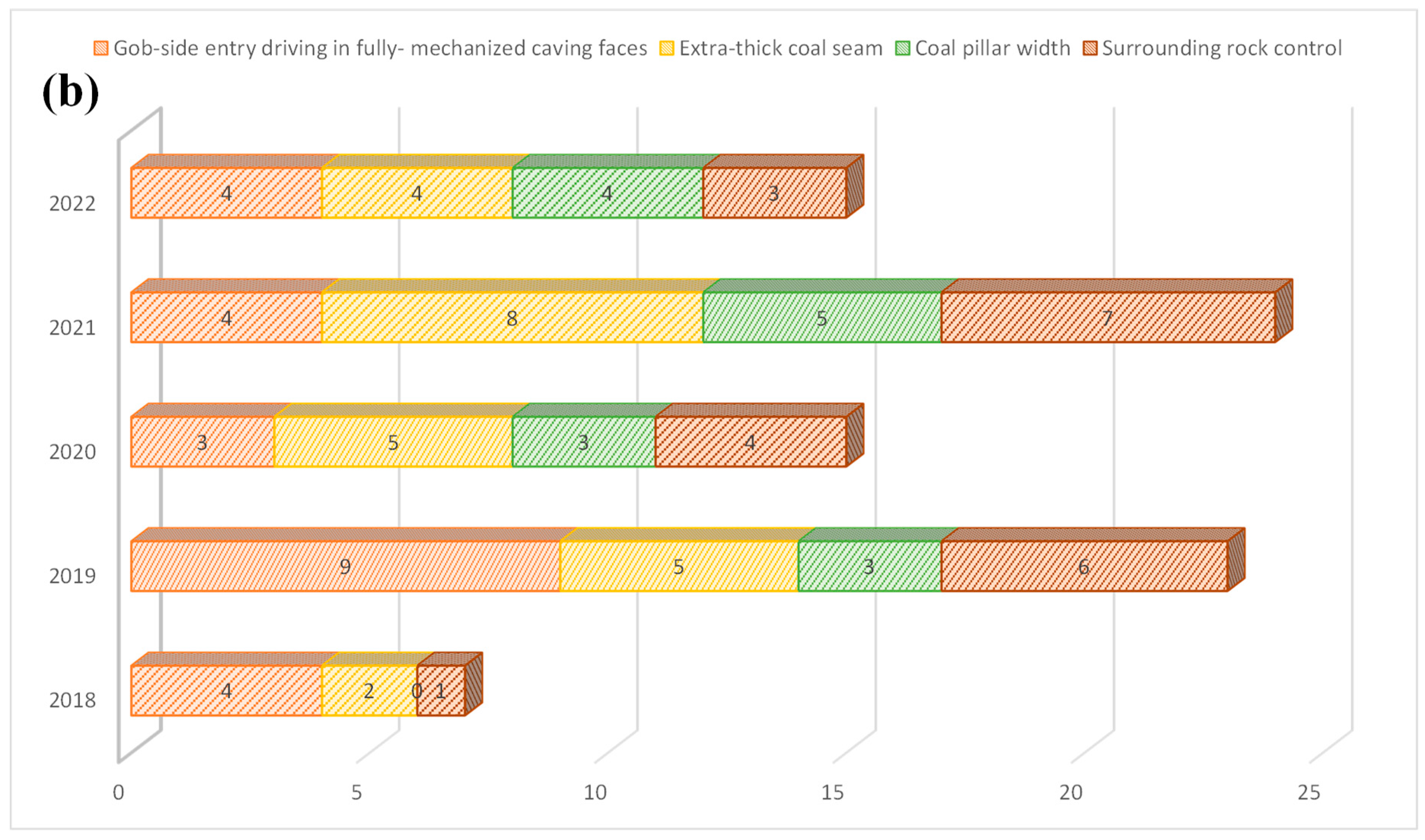



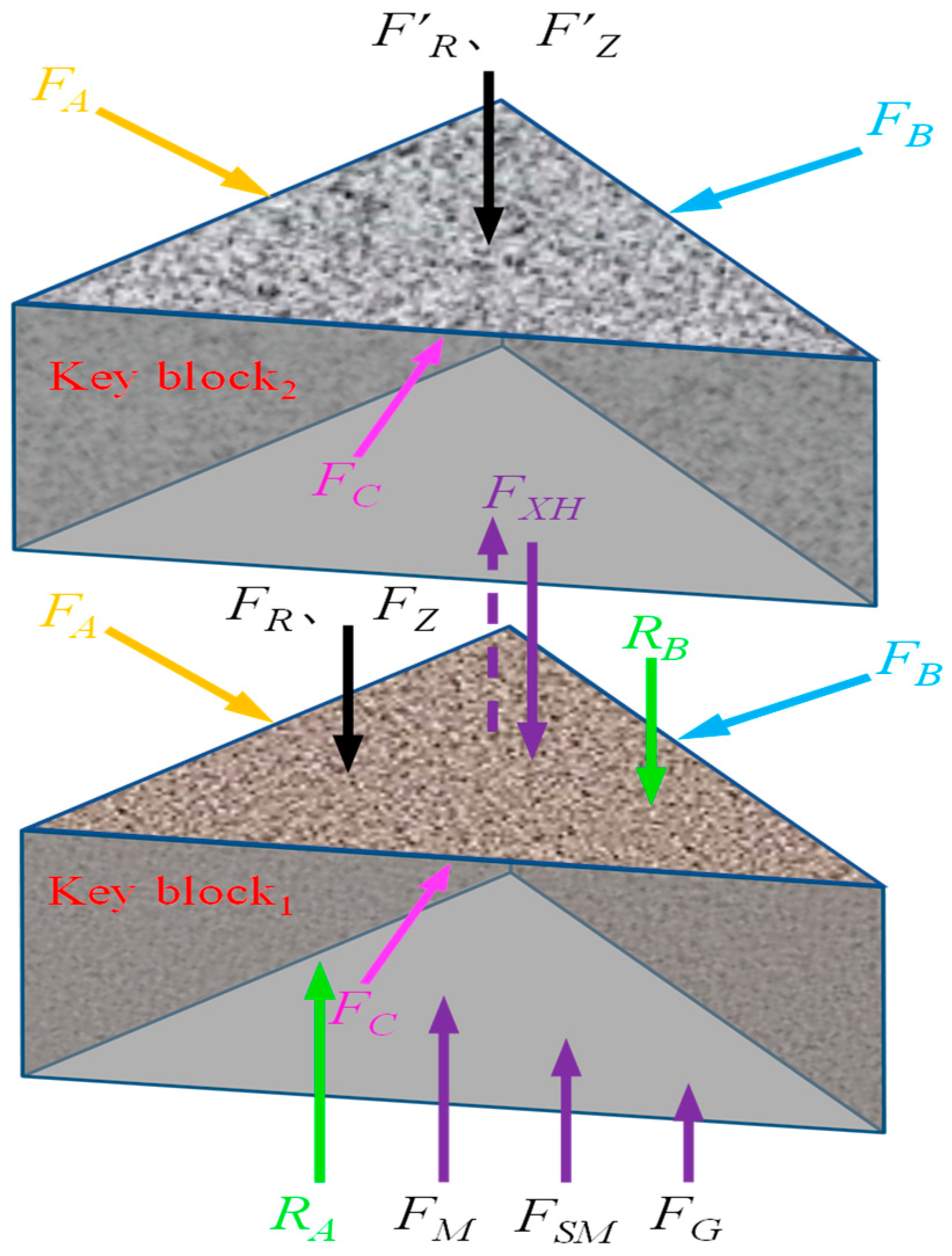
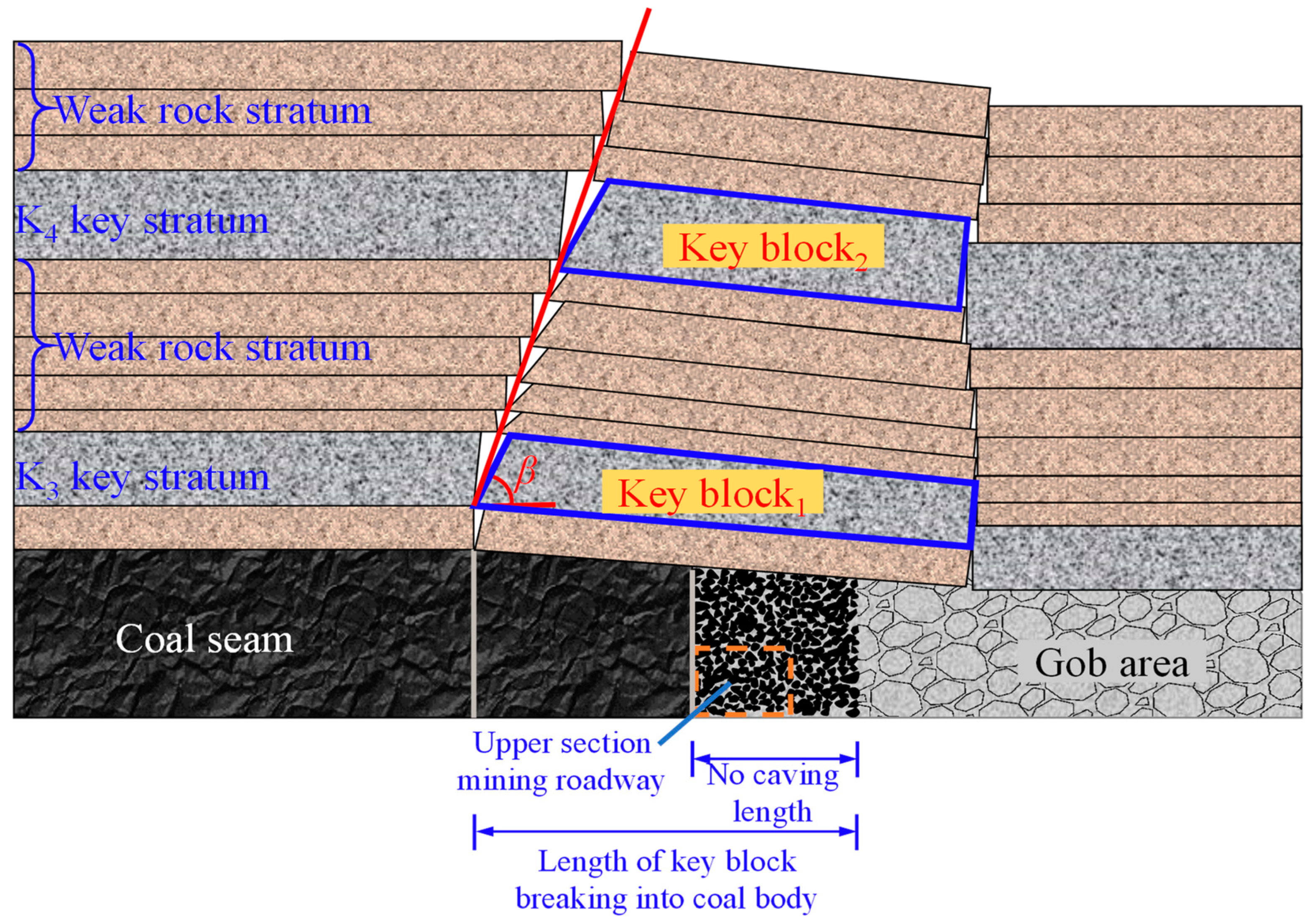


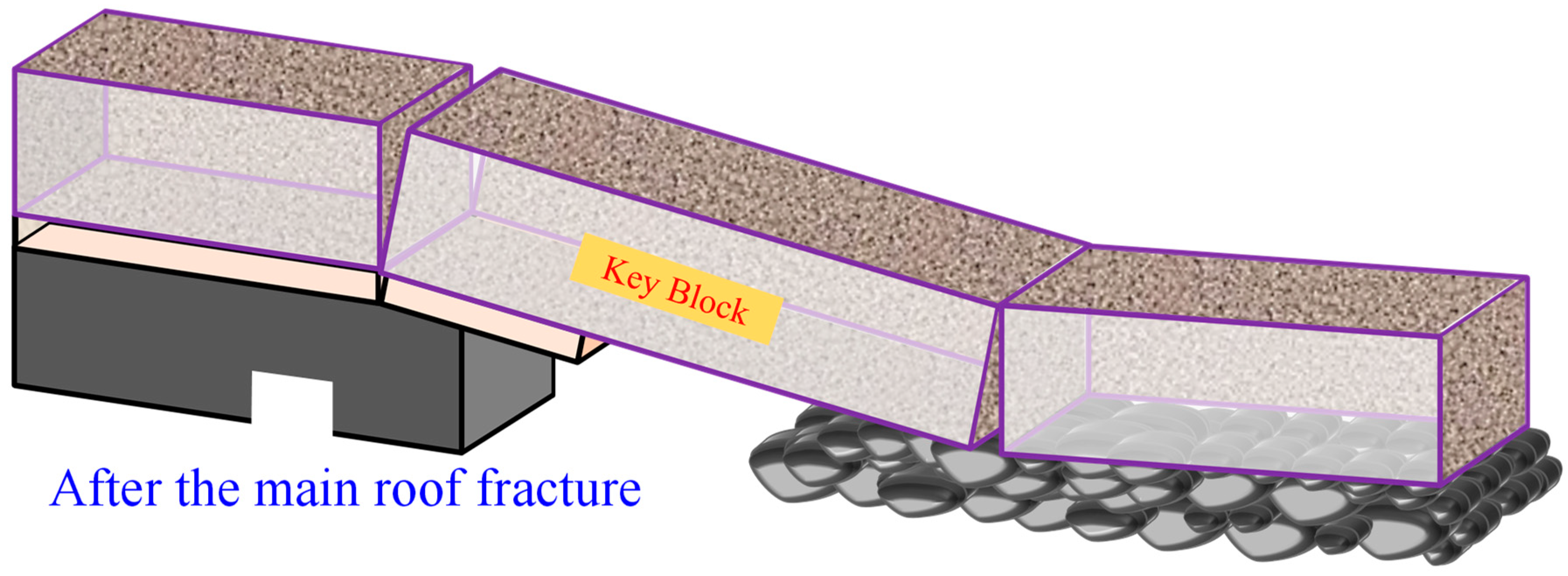


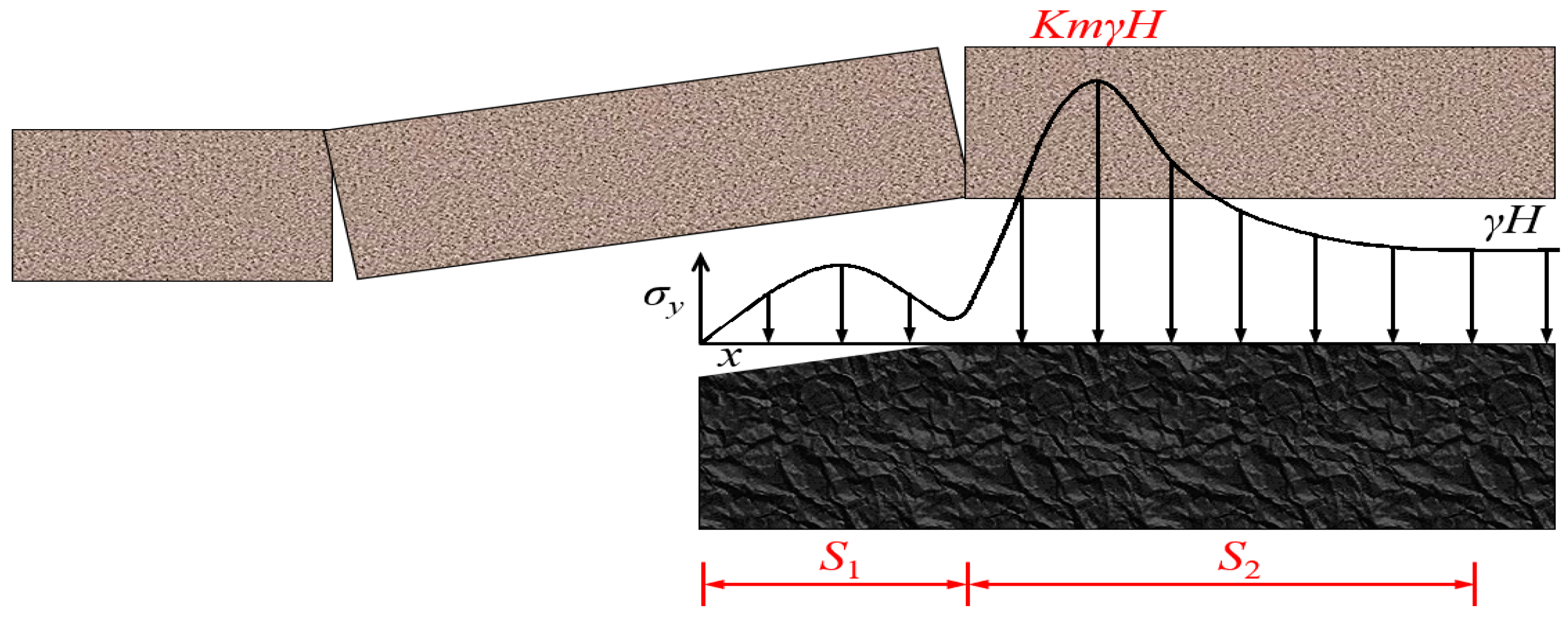




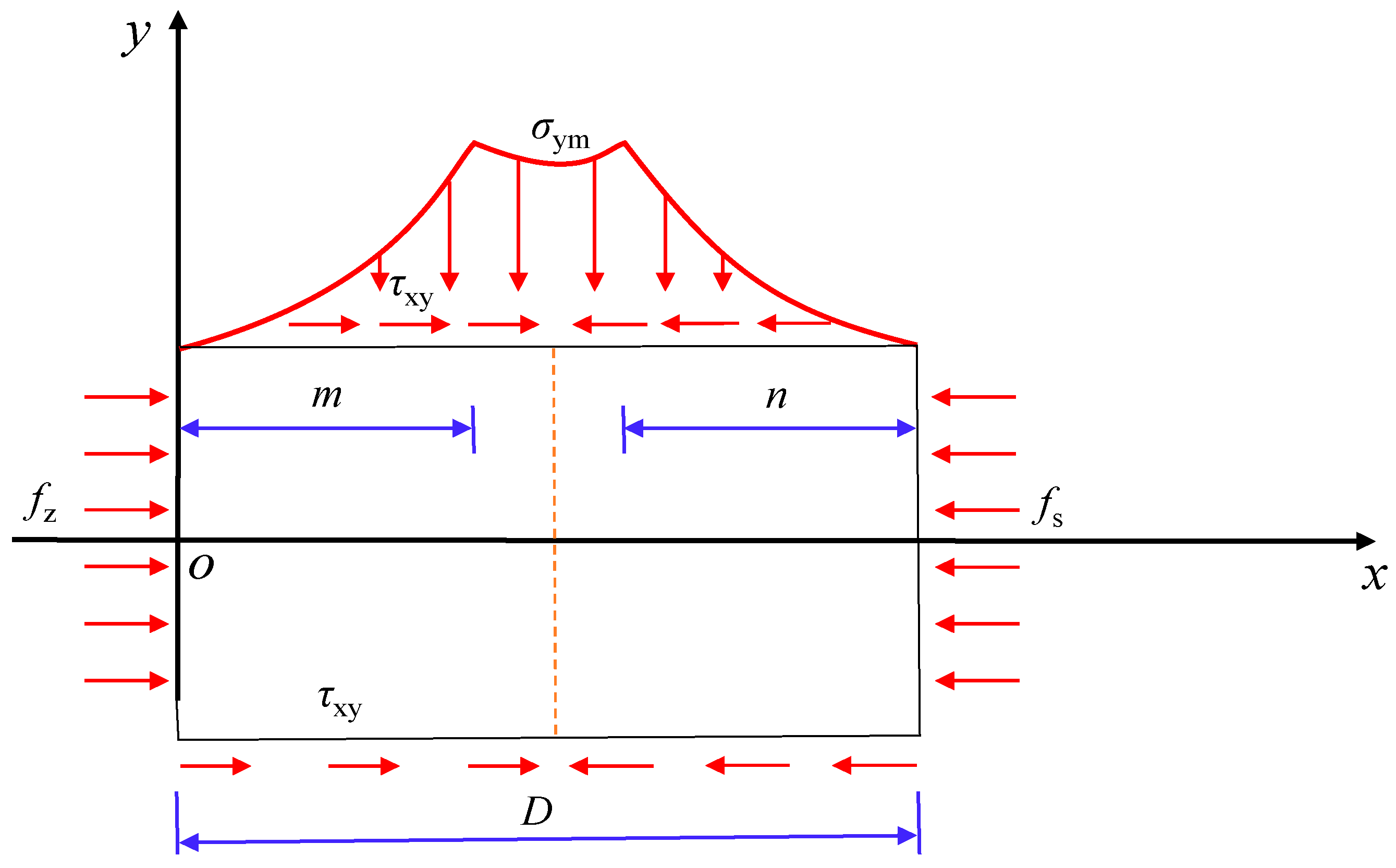
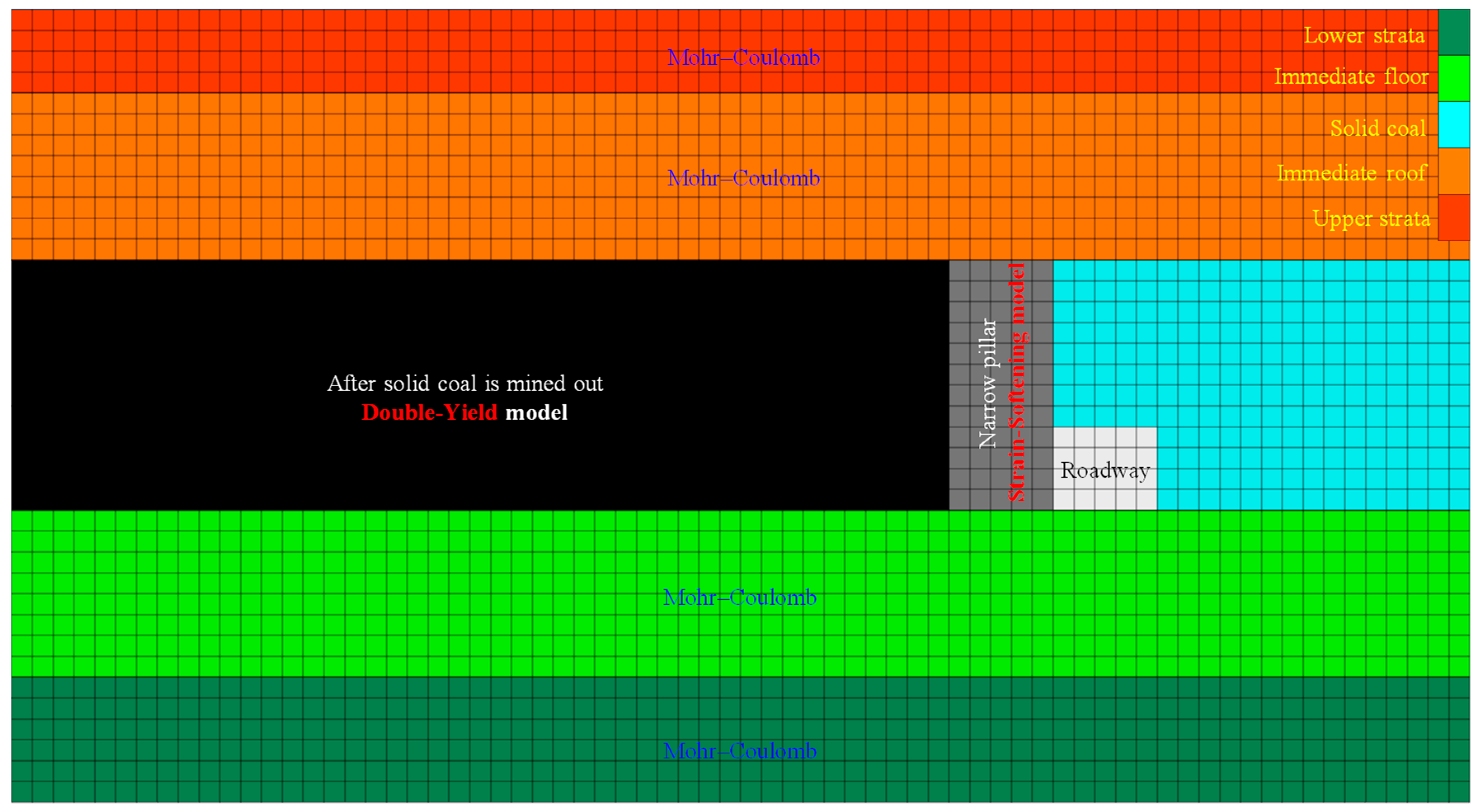

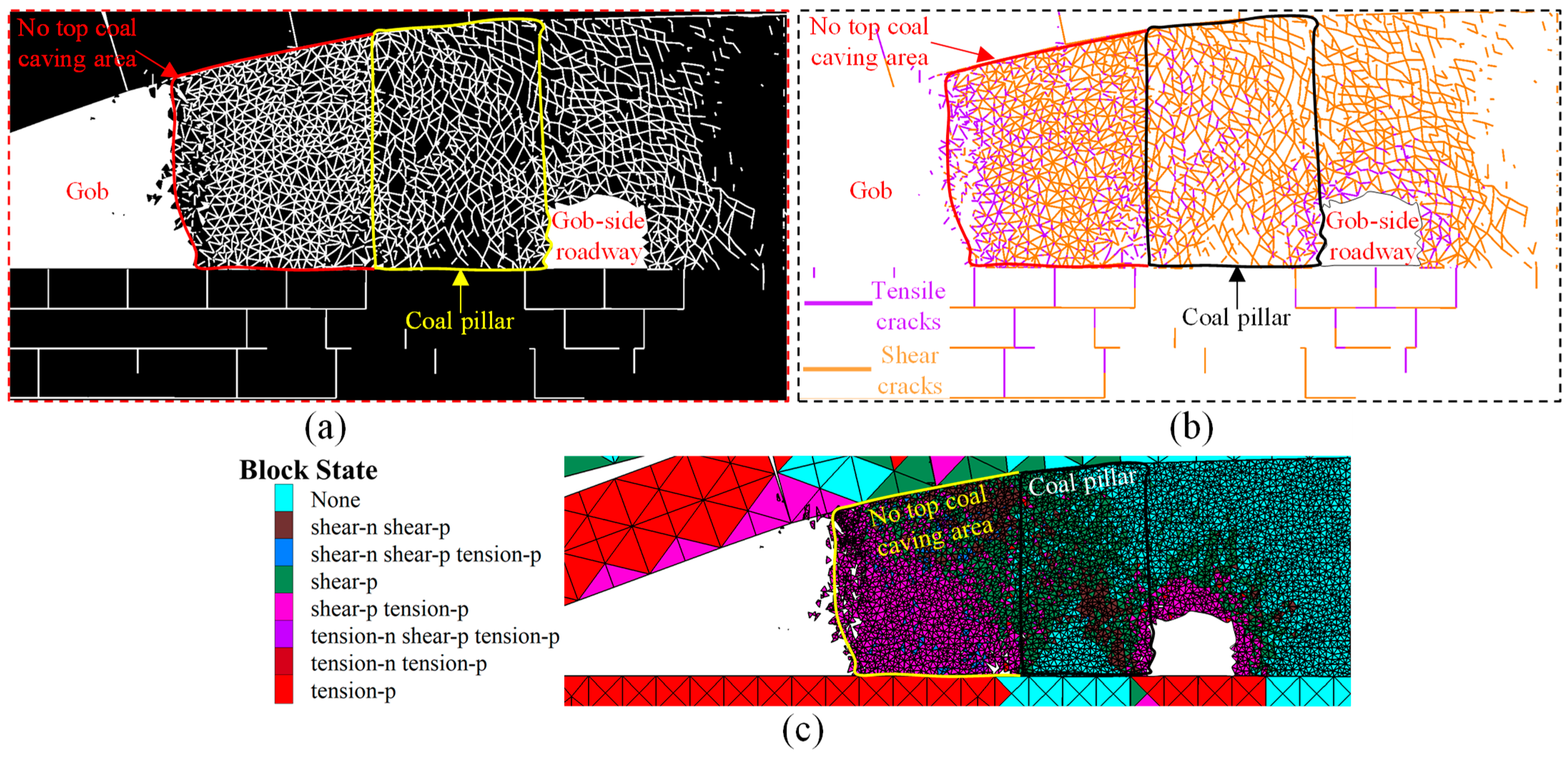
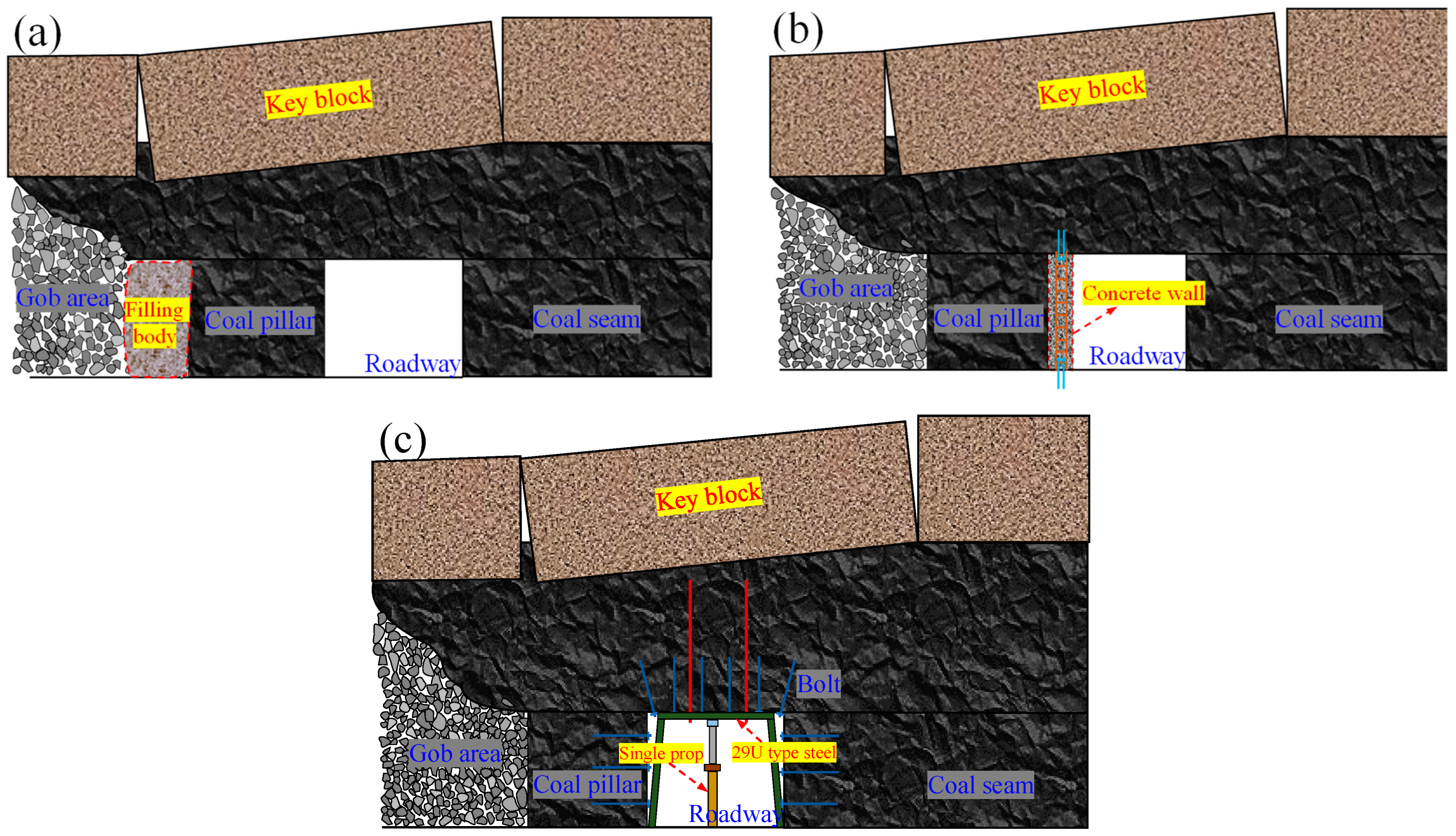
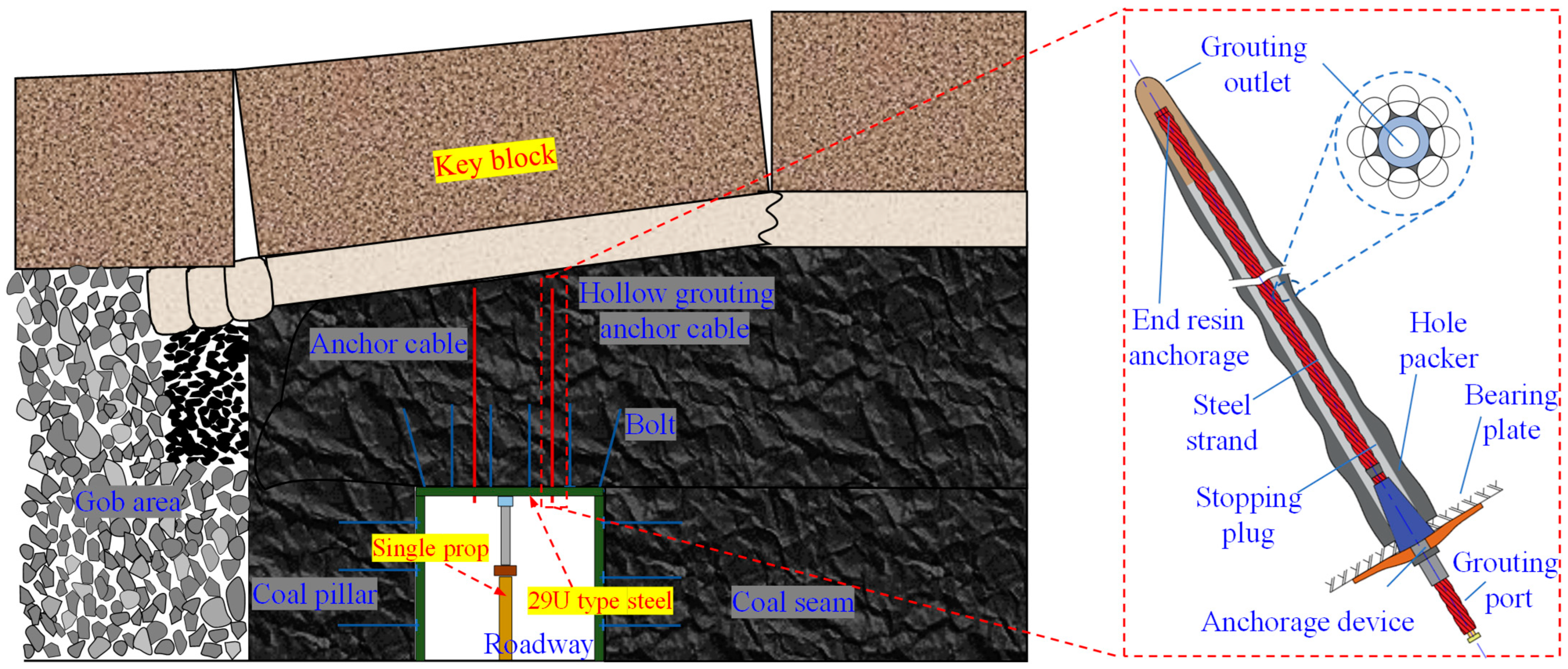

| Support Pattern | Bolt + Ladder Beam (W, JW Steel Strip) + Net | Single Anchor Cable | Anchor Cable + W, JW Steel Strip | Grouting | Roadway Side Concreate Wall | Gob Side Filling | Shelf | Anchor + Connecting Lock Device | Anchor + Channel Steel | Step Bundled Anchor Cable + Porous Large Tray | ||
|---|---|---|---|---|---|---|---|---|---|---|---|---|
| Support Position | ||||||||||||
| Pillar rib | Ⅰ | √ | ||||||||||
| Ⅱ | √ | |||||||||||
| Ⅲ | √ | √ | √ | |||||||||
| Ⅳ | √ | √ | √ | |||||||||
| Ⅴ | √ | √ | ||||||||||
| … | ||||||||||||
| Virgin coal rib | Ⅰ | √ | ||||||||||
| Ⅱ | √ | √ | ||||||||||
| Ⅲ | √ | √ | ||||||||||
| … | ||||||||||||
| Roadway roof | General support | √ | ||||||||||
| Anchor truss | Ⅰ | √ | √ | |||||||||
| Ⅱ | √ | √ | √ | |||||||||
| Step bundled anchor cable | √ | √ | √ | |||||||||
| … | ||||||||||||
| Special condition | Ⅰ | √ | √ | √ | ||||||||
| … | ||||||||||||
Disclaimer/Publisher’s Note: The statements, opinions and data contained in all publications are solely those of the individual author(s) and contributor(s) and not of MDPI and/or the editor(s). MDPI and/or the editor(s) disclaim responsibility for any injury to people or property resulting from any ideas, methods, instructions or products referred to in the content. |
© 2023 by the authors. Licensee MDPI, Basel, Switzerland. This article is an open access article distributed under the terms and conditions of the Creative Commons Attribution (CC BY) license (https://creativecommons.org/licenses/by/4.0/).
Share and Cite
Chen, D.; Zhu, J.; Ye, Q.; Ma, X.; Xie, S.; Guo, W.; Li, Z.; Wang, Z.; Feng, S.; Yan, X. Application of Gob-Side Entry Driving in Fully Mechanized Caving Mining: A Review of Theory and Technology. Energies 2023, 16, 2691. https://doi.org/10.3390/en16062691
Chen D, Zhu J, Ye Q, Ma X, Xie S, Guo W, Li Z, Wang Z, Feng S, Yan X. Application of Gob-Side Entry Driving in Fully Mechanized Caving Mining: A Review of Theory and Technology. Energies. 2023; 16(6):2691. https://doi.org/10.3390/en16062691
Chicago/Turabian StyleChen, Dongdong, Jingkun Zhu, Qiucheng Ye, Xiang Ma, Shengrong Xie, Wenke Guo, Zijian Li, Zhiqiang Wang, Shaohua Feng, and Xiangxiang Yan. 2023. "Application of Gob-Side Entry Driving in Fully Mechanized Caving Mining: A Review of Theory and Technology" Energies 16, no. 6: 2691. https://doi.org/10.3390/en16062691






